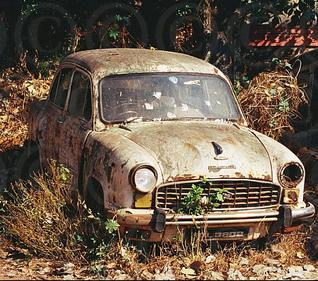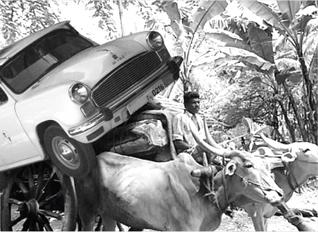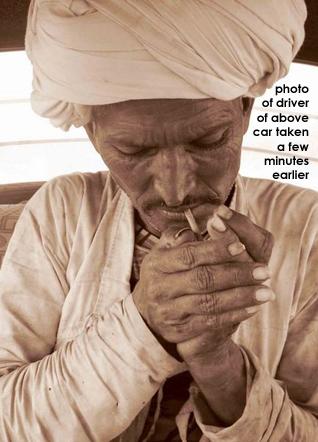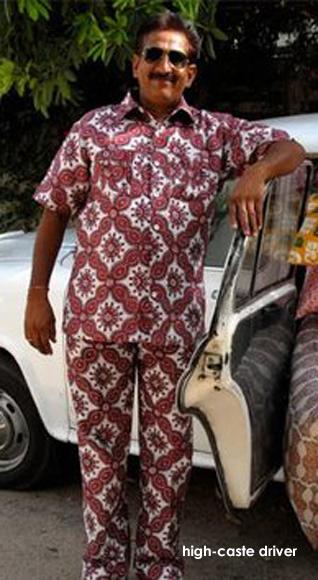Humour
Indian Highway Code
by RASHAKRISHNA
Traveling on India's roads is an almost hallucinatory potion of sound, spectacle and experience. It is frequently heart-rending, sometimes hilarious, mostly exhilarating, always unforgettable -- and, when you are on the roads, extremely dangerous.
Most Indian road users observe a version of the Highway Code based on an ancient Sanskrit text. The following 12 Rules of the Road, found in the same vedas which contain the master-plans of the Atom Bomb and the Urran Khatola.
They are being published for the
first time in English:
ARTICLE I:
The assumption of immortality is required of all road users.
ARTICLE II:
Indian traffic, like Indian society, is structured on a strict caste
system. The following precedence must be accorded at all times. In
descending order, give way to:
Cows, elephants, heavy trucks, buses, official cars, camels, light
trucks, buffalo, jeeps, ox-carts, private cars, motorcycles, scooters,
auto-rickshaws, pigs, pedal rickshaws, goats, bicycles (goods-carrying),
handcarts, bicycles (passenger-carrying), dogs, pedestrians.
ARTICLE III:
All wheeled vehicles shall be driven in accordance with the maxim: to
slow is to falter, to brake is to fail, to stop is defeat. This is the
Indian drivers' mantra.
ARTICLE IV:
Use of horn (also known as the sonic fender or aural amulet):
Cars (IV,1,a-c):
- Short blasts (urgent) indicate supremacy, i.e., in clearing dogs, rickshaws and pedestrians from path.
- Long blasts (desperate) denote supplication, i.e., to oncoming truck: "I am
going too fast to stop, so unless you slow down, we shall both die". In
extreme cases, this may be accompanied by flashing of headlights
(frantic).
- Single blast (casual) means: "I have seen someone out of India's 1.2 billion people whom I recognise", "There is a bird in the road (which at this
speed could go through my windscreen)" or "I have not blown my horn for
several minutes."
Trucks and buses (IV,2,a):
All horn signals have the same meaning, viz: "I have an all-up weight of
approximately 12.5 tons and have no intention of stopping, even if I
could." This signal may be emphasised by the use of headlamps.
Article IV remains subject to the provision of Order of Precedence in Article II above.
ARTICLE V:
All manoeuvres, use of horn and evasive action shall be left until the last possible moment.
ARTICLE VI:
In the absence of seat belts (which there is), car occupants shall wear
garlands of marigolds. These should be kept fastened at all times.
ARTICLE VII:
Rights of way:
Traffic entering a road from the left has priority. So has traffic from the right, and also traffic in the middle.
Lane discipline (VII,1):
All Indian traffic, at all times and irrespective of direction of travel, shall occupy the centre of the road.
ARTICLE VIII:
Roundabouts: India has no roundabouts. Apparent traffic islands in the
middle of crossroads have no traffic management function. Any other
impression should be ignored.
ARTICLE IX:
Overtaking is mandatory. Every moving vehicle is required to overtake
every other moving vehicle, irrespective of whether it has just
overtaken you.
Overtaking should only be undertaken in suitable conditions, such as in
the face of oncoming traffic, on blind bends, at junctions and in the
middle of villages/city centres. No more than two inches should be
allowed between your vehicle and the one you are passing -- and one inch
in the case of bicycles or pedestrians.
ARTICLE X:
Nirvana may be obtained through the head-on crash.
ARTICLE XI:
Reversing: no longer applicable since no vehicle in India has reverse gear.
[Note: ARTICLE XII was lost along with the Nuclear Weapon Papers, Rocket diagrams, Flying Machine blue-prints, etc., which - as you already know - fell into the Mother Ganga, were carried away by the oceans, until the Germans found them centuries later, deciphered them and dishonestly claimed them as their own.]
July 25, 2011
Conversation about this article
1: Sangat Singh (Kuala Lumpur, Malaysia), July 25, 2011, 7:14 PM.
Some 13 years ago, I decided to take the Punjab Roadways bus to travel from Patiala to Ludhiana. Naturally, the bus driver was a six-footer, burly Sardar. During that period, a Punjabi song - "Hai Jamalo", was the rage. I don't remember the lyrics, though. Within minutes of his taking his command seat, he inserted the cassette and turned it loud enough to be heard 20 miles away, and started to sing along to add extra mileage. Occasionally, he would let go of the steering wheel and move his hands in "wah wah". This was the time when the dual carriage-way was not yet constructed. It was a single, multipurpose road with no line to divide the road, and thus allowed the traffic to weave in and out impartially. It even allowed the shepherd herding goats to have the right of way. Of course, the burly bus driver's disdain was all too visible and as an added effect he would blare his horn to add to the accompanying invectives. Every now and then, we would pass a village that contributed scooters, auto-rickshaws, pigs, pedal rickshaws and bicycles to the traffic and allowed them unfettered access to the road as well. Despite these minor irritants, overtaking was mandatory. Every moving vehicle must overtake the one in front of it, but especially the one who has just overtaken you, and then you must occupy the middle of the road to give a fair chance to up and down traffic to hit you. After all, Singh is King! On this occasion, the two truck drivers rattling along towards us from the opposite direction, recognized each other, flashed their headlights, and braked to a grinding halt beside each other, wholly blocking the road. They exchanged shrill greetings with each other, reaching out to shake hands and then reluctantly went on their way, completely oblivious of the cacophony of horns from both sides of the divide with practiced indifference. Where can you get such camaraderie? If you want to see and feel India, take a Punjab Roadways bus, but with an assumption of immortality. If you survive, it was your own fault. On another occasion, my nephew picked me up from the airport and drove like mad. When I commented that he was a bad driver, his response was: "No Mama ji, I am a better driver than most ...the bad ones are all dead!"
2: Jagjeet Kaur (Petaling Jaya, Malaysia), July 30, 2011, 8:51 AM.
I read with great interest the above interesting comments by Sardar Sangat Singh from Malaysia on Rashakrishna's "Indian Highway Code". I too have had similar hair-raising experiences especially, on hair-pin bends and even in the heart of Delhi, while riding India's famed cabs. My first time on these highways kept me seated on the edge as I instinctively applied imaginary brakes every time the fluent English-speaking driver pressed on the accelerator and bounced along the road in the bone-shaker, which was in no road-condition, until he came to an abrupt halt smack in the middle of the road with all the trucks, cars and vans hooting and honking at him. The more concerned I was, the more indifferent he acted to all these sounds and noises! He was in total oblivion! Yet, believe me, he was to blame. And, my life was at stake. To my horror, he barked at the other cab drivers and told them, "I have guests from Malaysia. They asked me to pause here to take photos with their new Sony camera to take back to Malaysia. If you wait there, I will ask them to take some of yours too. With your number plate; then you can have more business!" All in all, the cab drivers were friendly and had a real sense of humour but were always willing to take you shopping and to restaurants with their favourite "Look! Look! Just look! Beautiful salwar kameez, just look; you don't have to buy here. Then I'll take you to another one!"
3: Gail Leach-Wunker (Ontario, Canada), January 08, 2012, 7:35 PM.
I was just in India for two weeks (my first trip) along with other family members. We were in line to get on an elephant to visit the Amber Fort when our guide read these "rules" to us from his Blackberry (yeah, Canada). We all laughed so much that we almost cried, having just had first-hand experience of these very rules!






